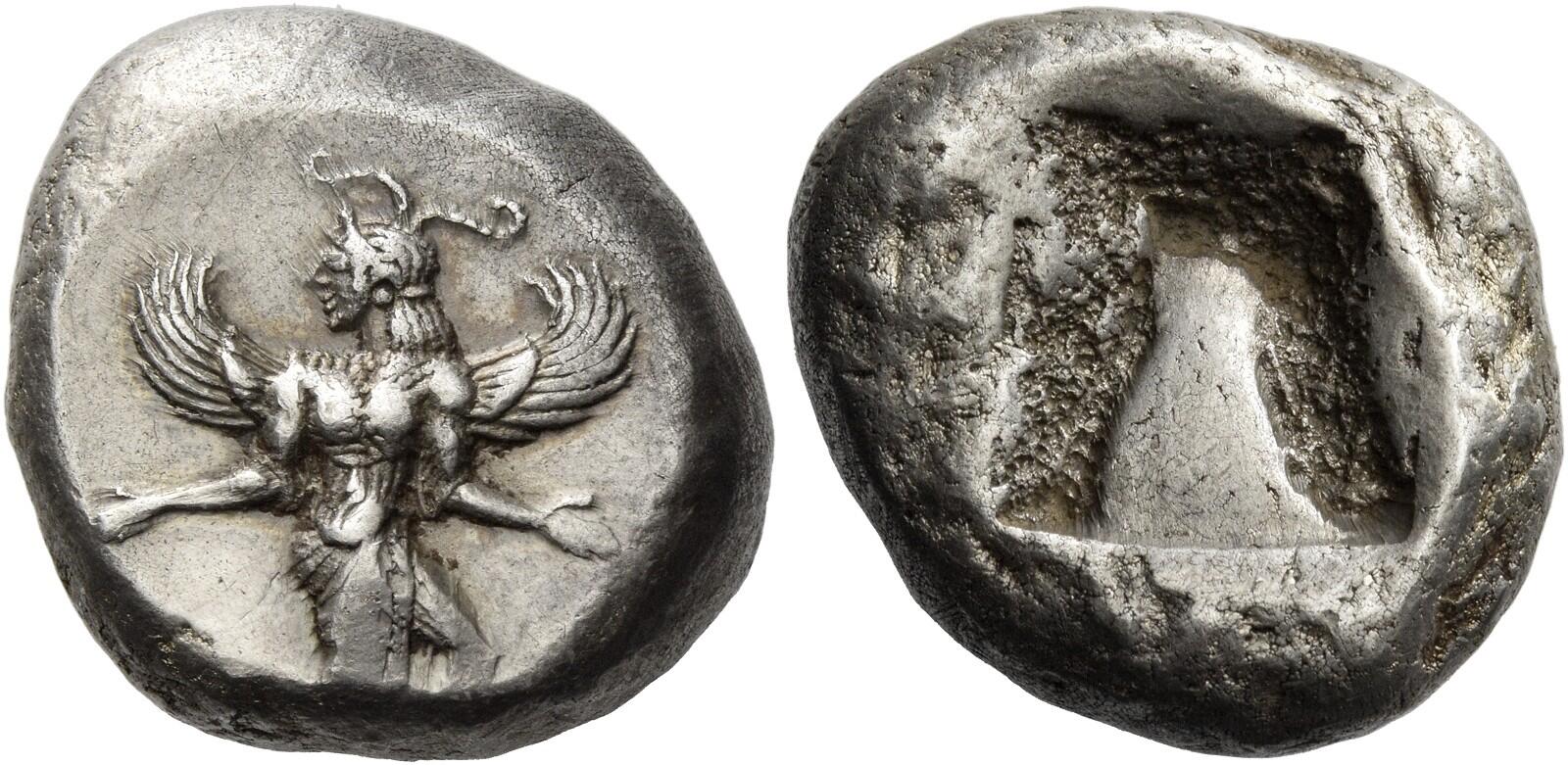AC 232 - Caunus, silver, stater, 490-390 BC
From SILVER
490 BCE - 390 BCE Silver 12,656 kg
Description
| ObverseInscription or printing placed on the obverse.: | Iris with curved wings and outstretched hands in a kneeling-running position right, head turned left, wearing a long chiton and two scrolls curling up from the top of her head. |
| ReverseInscription or printing placed on the reverse.: | Rough triangular shape in incuse square. |
Mint and issuing power
| MintIdentifies the place of manufacture or issue of a numismatic object.: | Caunus | Ancient regionAncient region.: | Caria | Modern countryModern country: Turkey | AuthorityIdentifies the issuing power. The authority can be "pretended" when the name or the portrait of X is on the coin but he/she was not the issuing power. It can also be "uncertain" when there is no mention of X on the coin but he/she was the issuing power according to the historical sources: |
Chronology
| FromIdentifies the initial date in a range assigned in a numismatic context. | 490 BCE | toIdentifies the final date in a range assigned in a numismatic context.. | 390 BCE | PeriodTime period of the numismatic object.: Archaic and Classical |
Physical description
| MetalThe physical material (usually metal) from which an object is made.: | Silver |
Median weightMedian of the weights of numismatic objects (in grams). in grams | 11.60 | DenominationTerm indicating the value of a numismatic object. Examples: tetradrachm, chalkous, denarius.: | stater |
StandardStandard.: |
Image

AC232 Caunus.jpeg [1]
References
| Die study referencePublication of the study: | Konuk 19981Konuk 1998, n° 1-15 et 71-116. | ||
| Coin series referenceReference to coin series study: | RQEMAC2RQEMAC, n° 232 | ||
| Coin series web referenceCoin series web references: | |||
Obverse dies distribution
| FrequencyFrequency of specimen in distribution. ᵖ | Number of obversesNumber of obverse dies. ᵖ (o) | % (o) | Number of coinsNumber of coins. (n) | % (n) | Die nameName(s) of the die(s). |
| 1 | 13 | 25 | 13 | 3.43 | 5, 6, 7, 10, 11, 13, 18, 20, 21, 25, 28, 34, 45 |
| 2 | 9 | 17.31 | 18 | 4.75 | 4, 12, 22, 27, 29, 35, 43, 47, 48 |
| 3 | 6 | 11.54 | 18 | 4.75 | 19, 23, 24, 40, 46, 49 |
| 4 | 7 | 13.46 | 28 | 7.39 | 3, 16, 17, 26, 32, 37, 44 |
| 5 | 1 | 1.92 | 5 | 1.32 | 54 |
| 6 | 1 | 1.92 | 6 | 1.58 | 52 |
| 8 | 3 | 5.77 | 24 | 6.33 | 2, 30, 50 |
| 10 | 1 | 1.92 | 10 | 2.64 | 31 |
| 11 | 2 | 3.85 | 22 | 5.8 | 1, 51 |
| 12 | 1 | 1.92 | 12 | 3.17 | 8 |
| 14 | 1 | 1.92 | 14 | 3.69 | 9 |
| 15 | 1 | 1.92 | 15 | 3.96 | 38 |
| 19 | 1 | 1.92 | 19 | 5.01 | 53 |
| 20 | 2 | 3.85 | 40 | 10.55 | 33, 39 |
| 24 | 1 | 1.92 | 24 | 6.33 | 41 |
| 35 | 1 | 1.92 | 35 | 9.23 | 36 |
| 76 | 1 | 1.92 | 76 | 20.05 | |
| Total | 52 of 52 | 99.98 | 379 of 379 | 99.98 |
Reverse dies distribution
no distribution is available
Quantification
| Number of obversesNumber of obverse dies. ᵖ (o) | 52 | Number of singletons (o1)The number of singleton coins. ᵖ | 13 |
| Number of reverse diesNumber of reverse dies. (r) | 56 | Number of coinsNumber of coins. (n) | 379 |
| Coins per obverse dieNumber of coins per obverse die. (n/o) | 7.29 | Coins per reverse dieNumber of coins per reverse die. (n/r) | 6.77 |
| Reverse per obverse ratioRatio of obverse dies divided by reverse dies. (r/o) | 1.08 | Percentage of singletons (o1)number of coins (n) divided by the number of singletons (o1) ᵖ | 25 % |
| Original number of dies (O) (Carter 1983 formula)The estimation of the number of coins according to Carter 1983 ᵖ | 54.55 | Coins struck if 20,000 as average productivity per dieCoins made if the average productivity for obverses (according to Carter) is 20,000. ᵖ | 1,091,000 |
| Original number of dies (O) (Esty 2011 formula)The estimation of the number of coins according to the singleton formula in Esty 2011 ᵖ (O) | 60.27 | Survival rate if 20,000 as average productivity per dieSurvival rate if average productivity is 20,000. ᵖ | 0.00035 |
| Coverage (o = % of O) (Esty 1984 formula)Esty 1984 - coverage (% of O) ᵖ (o = % of O) | 96.57% | Die productivity if survival rate 1/2,000Average productivity if survival rate is 1/2,000. ᵖ | 13,895.51 |
| Weight of silver (in kg) if 20,000 coins per die (O = Carter formula)Carter 1983 * Median weight * 20000 (*10 if gold or electrum) ᵖ | 12,656 kg <br /> 12,656 kg | Die productivity if survival rate 1/5,000Average productivity if survival rate is 1/5,000. ᵖ | 34,738.77 |
Remarks
Most likely one single workstation
References
- ^ Konuk, Koray (1998), "The Early Coinage of Kaunos", in Richard Ashton and Silvia Hurter (eds.), Studies in Greek Numismatics in Memory of Martin Jessop Price, London, p. 5-
- ^ Callataÿ, François de (2003), Recueil quantitatif des émissions monétaires archaïques et classiques, Numismatique Romaine, Wetteren, VII + 267 p.